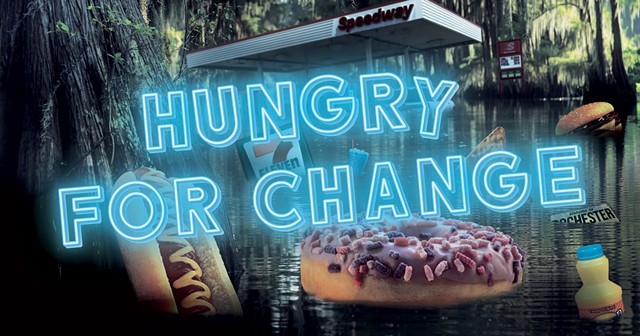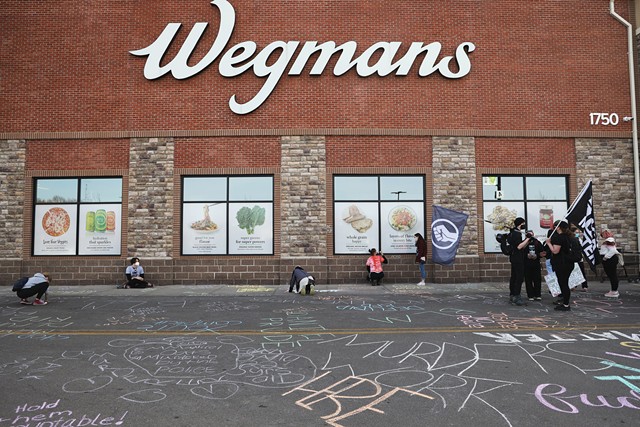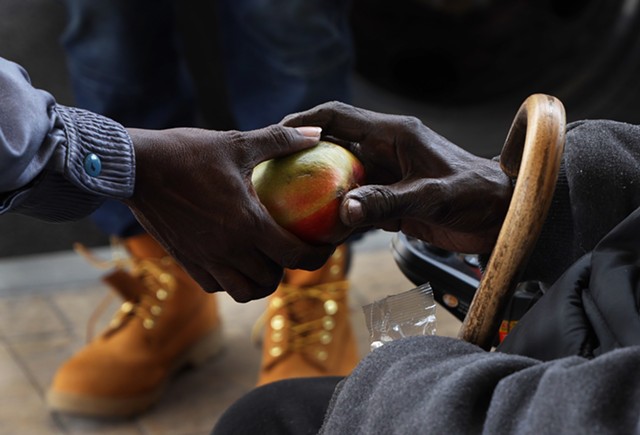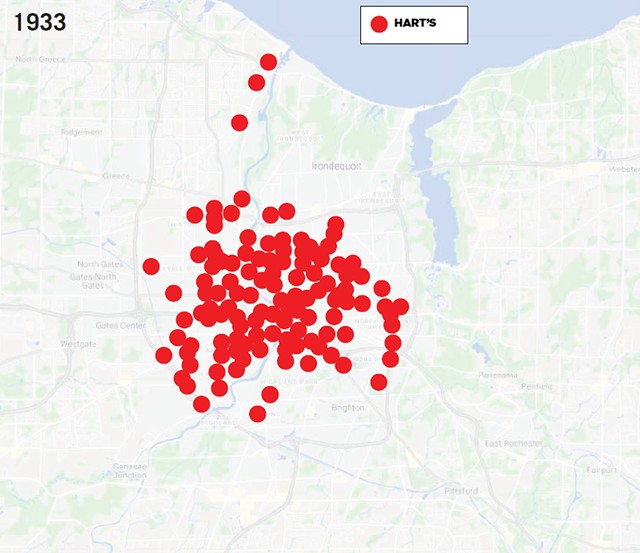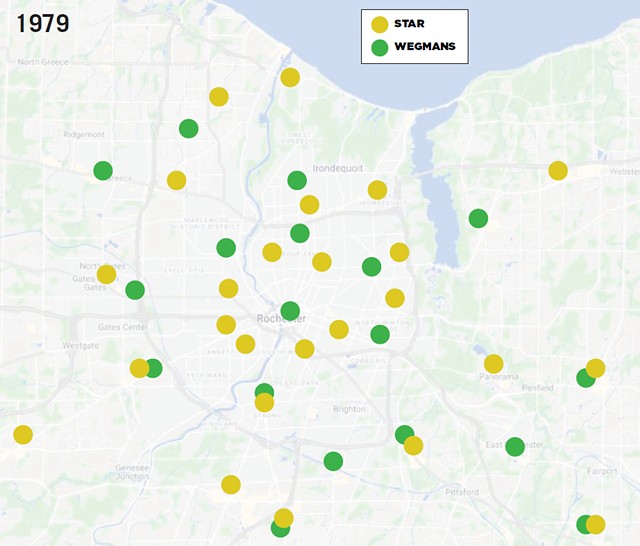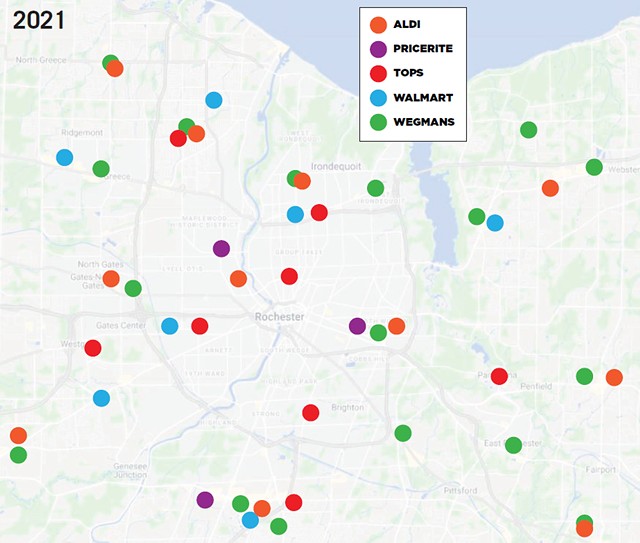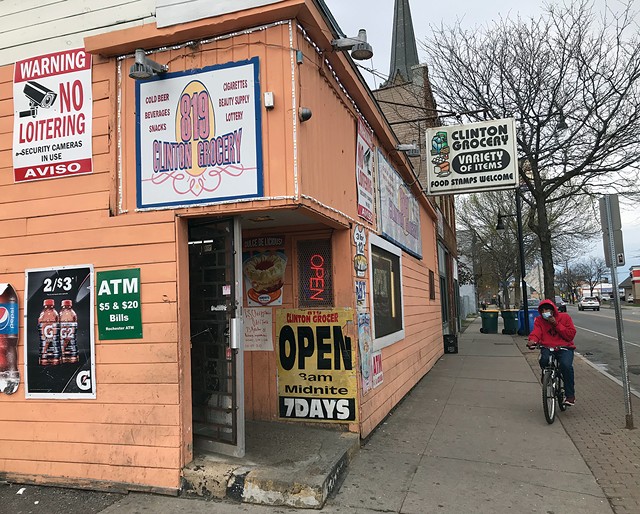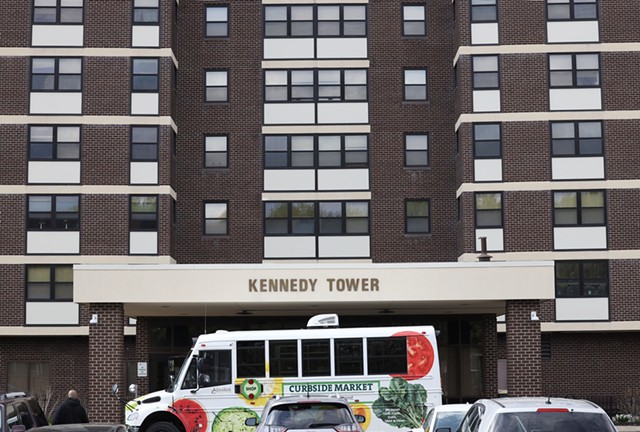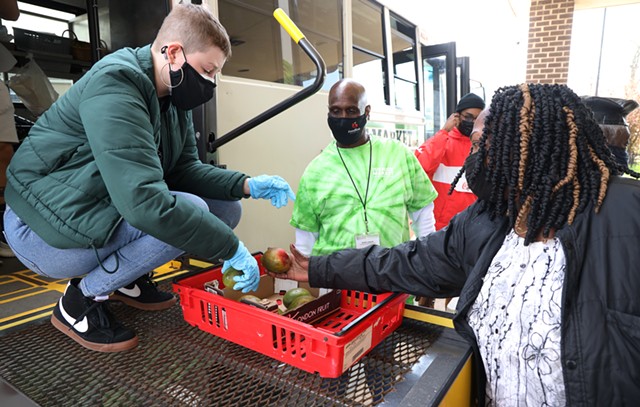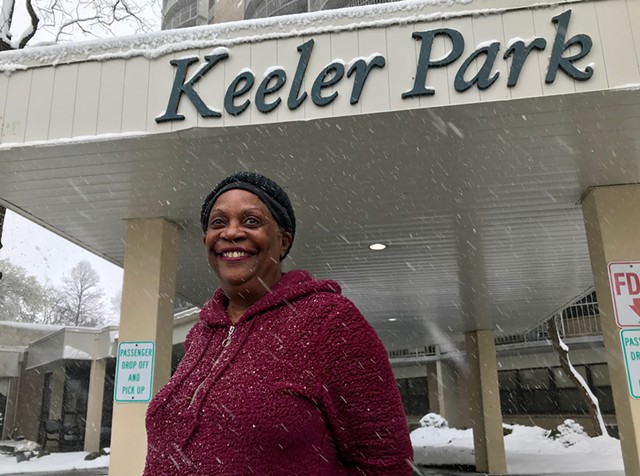New Food Policy Council looking to drain Rochester's 'food swamp'
By David Andreatta @david_andreatta[
{
"name": "500x250 Ad",
"insertPoint": "5",
"component": "15667920",
"parentWrapperClass": "",
"requiredCountToDisplay": "1"
}
]
On the anniversary of Daniel Prude’s fatal encounter with Rochester police, scores of demonstrators marched east from downtown to take over the parking lot at the East Avenue Wegmans, eventually prompting the store to close for the day.
“Wegmans exemplifies what’s wrong in our community,” Justin Morris, president of the Rochester Chapter of the Arc of Justice, a grassroots group for social change, said at the protest.
Around him, demonstrators wrote Black Lives Matter slogans in chalk on the asphalt as Wegmans workers locked themselves and shoppers behind the store’s glass doors.
“Wegmans started in the inner-city, in some of our most vulnerable communities, then they got their check and left,” Morris said. “There is no reason why Danny Wegman is having so much success, but in the city we have food deserts.”
Nearly every neighborhood in Rochester is what is commonly called a food desert, a now outdated term adopted by the U.S. Department of Agriculture to describe a low-income area with few places where residents can easily buy healthy food.
But Rochester is really more of what food policy analysts are nowadays calling a “food swamp,” an urban area with an abundance of food that is unhealthy and where healthy food is hard to find or afford. The result is what they call “food apartheid” — systemic unequal access to nutritious food that is grounded in man-made structural inequities of income, education, and race.
In reflecting on his remarks a month later, Morris acknowledged that stamping Rochester with the food desert label oversimplifies what has happened here since Wegmans crushed its competition in the city and all but pulled out more than a generation ago.
“What we have now are corner stores,” he said. “They put up these fly-by-night menus and they’re all the same — fried chicken, steak subs, and French fries. That’s universally on every corner in Rochester.”
“They have almost no healthy options,” Morris went on. “If there is one, it’s usually a rotten banana.”
Untangling the complicated web of structural inequities that has degraded access to healthy foods is what Rochester hopes to accomplish with the introduction of a Food Policy Council, which is expected to be approved by City Council in May.
City officials, food policy analysts, and activists hungry for change have been devising the structure of the new Food Policy Council for the better part of a year through a series of virtual meetings that concluded in April.
The sessions, jointly hosted by representatives of the city, Common Ground Health, and Foodlink, were attended by hundreds of city residents.
“There has been a tremendous interest in this,” said Mike Bulger, of Common Ground Health. “This is something that people in Rochester have been talking about for decades. We’re not proposing anything that we need to convince everyone is needed. I think there’s a — pun intended — big appetite for this.”
A ‘DEPARTMENT OF FOOD’
Food policy councils have been around for about 40 years, with the first having been introduced in Knoxville, Tennessee, in 1982. Today, they’re everywhere, with more than 300 nationwide, according to the Food Policy Networks of the Johns Hopkins Center for a Livable Future. There are eight in New York, including in Buffalo, Syracuse, and Long Island.
These councils are typically initiated by local governments through acts of legislation or executive order, but they are not another level of government in most cases. They are usually run by volunteers and function separate from local government, but act as advisors to policy makers. Advocates like to think of them as an outside “Department of Food.”
The council envisioned for Rochester, for instance, will include 13 members, including 10 city residents and three administrators representing the city, Common Ground Health, and Foodlink, which are to provide staff support for the council’s operations. The council is to be funded by a $100,000 Healthy Cities and Counties Challenge grant.
Members are tasked with bringing together stakeholders from every sector of the food system — production, consumption, distribution, and waste — and coming up with ways to increase access to and the consumption of healthy foods.
That could mean building bridges between government, nonprofit organizations, and the private sector. Or it could mean nudging government to enact policies aimed at enhancing healthy food options for city residents.
For instance, in Fort Worth, Texas, the county food policy council had a hand in pushing the city to pass an ordinance last year banning the development of new dollar stores within two miles of existing ones and requiring new ones to devote 10 percent of their floor space to fresh produce, meat, and dairy products.
Another example could be found in Baltimore. The food policy council there recently helped devise a partnership between the city and the ride-sharing service Lyft to subsidize transportation to grocery stores for residents of some low-income neighborhoods.
New York City is one of the few localities whose food policy council is part of city government. A few months ago the Office of Food Policy unveiled a 10-year plan dubbed Food Forward NYC that outlined a framework for a more equitable and sustainable food system.
Mark Winne, a senior advisor to the Food Policy Networks, is considered by some in the industry to be the godfather of food policy councils and advised the players behind Rochester’s council.
He was behind one of the earliest councils in Hartford, Connecticut, where, like Rochester, supermarkets had largely abandoned the city for the suburbs. The Hartford Advisory Commission on Food Policy prodded the local transit authority to restructure its routes to accommodate city residents who wanted to get to those grocery stores in the suburbs but had limited access to transportation.
“There’s a tendency to come up with one solution but you need multiple interventions working around things like food choices, food prices, transportation,” Winne said. “It’s more like ‘surround sound.’”
“When talking about food deserts, the first place we think to go is to put in a grocery store,” he went on. “That really isn’t enough.”
LESSONS FROM CONSTANTINO’S
Rochester learned the hard way that quenching a so-called food desert isn’t as simple as dropping a grocery store in the neighborhood.
Recall the cautionary tale of Constantino’s Market, a Cleveland-based grocery store that came to Mt. Hope Avenue in College Town in 2015 and closed 10 months later for lack of business.
The neighborhood had been designated a food desert after Wegmans closed its store on Mt. Hope in 2003, reversing course on a previously announced expansion there. The food desert label meant federal subsidies were available to grocers willing to move into the neighborhood.
In the case of Constantino’s, some $748,000 was given to the nonprofit Action for a Better Community to loan to Constantino’s at a discount rate in exchange for the grocer hiring 15 to 20 workers from low-income backgrounds.
The market was upscale — and so were its prices. Staple items like bread, milk, and juice were 20-, 30-, and 50-percent higher at Constantino’s than the next closest grocery store, a Tops, located about 2 miles away just over the city limits in Brighton.
Ultimately, taxpayers were left holding the bag.
The lesson to be learned from Constantino’s, said City Councilmember Mitch Gruber, was not that neighborhood residents didn’t want a grocery store. The lesson, he said, was that supermarkets whose business models don’t have room for low profit margins won’t stick around.
“The problem was misdiagnosed,” said Gruber, a member of the Rochester Food Policy Council planning team. “The problem is we have certain parts of our community that for various reasons have not been able to sustain a for-profit grocery store.”
To that end, an experiment taking place in the rural town of Baldwin, Florida, is intriguing to Gruber.
There, when the only grocery store closed three years ago, the town government opened its own. All of the store’s employees, from butchers to cashiers, are on the municipal payroll.
Unlike private supermarkets, the goal of the Baldwin Market isn’t to make a profit. It is to break even and keep the store running to accommodate the town’s 1,600 residents who would otherwise have to drive 10 miles to the nearest supermarket.
But breaking even is not easy in a business with notoriously low profit margins. Residents have reportedly complained of higher-than-average prices at Baldwin Market, and the town council has hinted that it will pull the plug if the store proves to be a financial drain.
“I don’t think something like that could work in Rochester,” Gruber said. “That’s a unique thing for a rural community. But I do think the same practices and principles can work here.”
HOW THE HOME OF WEGMANS BECAME A FOOD SWAMP
There is no one in Rochester closer to the intersection of food policy and potential municipal intervention in the food system than Gruber, who in addition to sitting on the City Council is the chief strategy and partnerships officer at Foodlink.
He said Foodlink has been noodling the concept of a mission-driven grocery store, where, like the municipal-run supermarket in Florida, profits are secondary to servicing a community in need.
The idea, along with the creation of a food policy council, was something he advocated for in a dissertation he wrote four years ago for his doctoral degree in history from the University of Rochester.
The 250-page paper explores what he called the “degradation of the food retail landscape” in Rochester by tracing the flight of Rochester’s foremost grocers from the city limits. It is essential reading for anyone who wants to know how Rochester became the food swamp it is today.
Early in the last century, according to Gruber, the Public Market was the funnel for nearly all food that flowed in and out of the city. Private grocers, of which there were many, procured their daily stock there. Municipal officials managed the operation, oversaw the weights and measures, and inspected the food.
That began to change, according to Gruber, in the mid-1920s, when the prominent grocers of the day, including Hart’s, A&P, and Flickinger’s, effectively privatized the food funnel by building their own warehouses as a way to assert more control over their inventory.
Hart’s won the grocery chain war, growing to 121 locations in Rochester by 1933 — twice as many stores as any of its competitors and almost four locations per square mile.
When managing that many stores cut into profits by the 1940s, however, the stratification of the food landscape by class and neighborhood began.
Hart’s began experimenting with the then new concept of “supermarkets,” opening larger stores it branded as Star Supermarkets, mostly in suburbs that were quickly becoming populated by white middle-class families leaving the city, and closing smaller Hart’s locations in the city, where low-income Black families were migrating from the South.
By 1955, there were 36 Star Supermarkets and 28 Hart’s stores in and around Rochester. Hart’s eventually converted all of its stores to Star Supermarkets, and when Wegmans began to expand in earnest, it followed the same model, according to Gruber.
At the dawn of the 1980s, Star and Wegmans accounted for nearly three-quarters of all grocery sales in Rochester and collectively ran 28 stores in the suburbs and just 17 in the city.
When Star went out of business in 1982 after falling to Wegmans in a “coupon war,” Wegmans owned 60 percent of the grocery market share and accelerated the closing of city stores to open new ones in the suburbs and beyond.
By 2007, the East Avenue Wegmans was the last of the chain in the city. The company has 104 locations across seven states, including 17 in Monroe County.
The void of supermarkets in Rochester has been filled to some extent by the likes of Tops, and the limited-assortment grocery stores of Price Rite and Aldi.
But the vacuum was mostly filled by the proliferation of corner stores whose signage advertise cigarettes, beer, and lottery tickets as prominently as they do groceries.
COOKING UP CHANGE
Some initiatives have been taken to enhance food access and level the playing field in poor Rochester neighborhoods.
After the protest shut down its East Avenue store, Wegmans issued a statement saying it stands for diversity and inclusion for all, and noting that the company has “spent over $150 million dollars educating, training and developing folks in need in the Rochester community.”
Wegmans runs weekly shuttles from low-income apartment buildings to its suburban stores. But, as people who use them pointed out, the service requires that they plan their shopping around the shuttle schedule.
It is not always convenient for Troy Mitsuda, 60, who lives in the Kennedy Tower on South Plymouth Avenue. He has no car and relies on a bus to get to his preferred Wegmans in Henrietta. The journey is a two-hour round trip.
He described his travels while picking up a handful of items at a Foodlink Curbside Market, a mobile market stocked with fresh fruits and vegetables that stops for an hour at his building once a week.
The mobile market, which was developed by Gruber as a solution to food inequity, has been running since 2013 and services sites in six counties, including housing complexes, senior centers, health clinics, and community centers in Rochester.
Melody Hickman, 59, a Kennedy Tower resident, said she shops at the mobile market every week. But that hasn’t changed her desire for a neighborhood grocery store.
“All we need around here is a grocery store,” said Hickman, who bought some avocados from the Foodlink truck. “That’s all anyone talks about — a grocery store and a laundry mat. But we need a grocery store the most.”
There is a growing body of evidence, however, that merely plonking down a supermarket in a so-called food desert does little to improve the overall health of residents.
Research published in the Quarterly Journal of Economics in 2019 studied grocery store purchases of 10,000 households in neighborhoods nationwide that had been labeled food deserts and had gotten a grocery store.
What researchers found was that not only did the households buy fewer healthy foods than people in wealthier neighborhoods, but also that they bought the same groceries at the new store that they had been buying all along.
In other words, giving poor people easier access to healthy foods doesn’t mean they’ll buy them. The cost of food, combined with people’s eating habits, were much more influential than convenience.
For example, those avocados Hickman bought at the Foodlink mobile market sold for 75 cents apiece. A suburban Wegmans on the same day was asking $1.49 for each.
The same pattern was discovered by the National Bureau of Economic Research in 2015. Researchers there found that no more than a tenth of the variation in the food people bought could be explained by the availability of a nearby grocery store.
Education, the researchers found, was more predictive of food purchases. The purchases of shoppers with lower levels of income and education living in neighborhoods with more accessible healthy food, mimicked that of low-income, less educated people in poorer neighborhoods. And the reverse was true, too.
Those findings did not surprise Luvene Ford, the tenant association president at Keeler Park Apartments on Hudson Avenue in northeast Rochester and a member of the Food Policy Council planning team.
She sees developing nutrition education as central to the goals of the council, of which she hopes to be a part as a full-fledged member in the coming months.
“It’s education and access,” Ford said. “Some people don’t have the transportation. They can take the shuttle or the bus, but I mean, how many groceries can you really carry on a bus?”
David Andreatta is CITY's editor. He can be reached at [email protected].
“Wegmans exemplifies what’s wrong in our community,” Justin Morris, president of the Rochester Chapter of the Arc of Justice, a grassroots group for social change, said at the protest.
Around him, demonstrators wrote Black Lives Matter slogans in chalk on the asphalt as Wegmans workers locked themselves and shoppers behind the store’s glass doors.
“Wegmans started in the inner-city, in some of our most vulnerable communities, then they got their check and left,” Morris said. “There is no reason why Danny Wegman is having so much success, but in the city we have food deserts.”
Nearly every neighborhood in Rochester is what is commonly called a food desert, a now outdated term adopted by the U.S. Department of Agriculture to describe a low-income area with few places where residents can easily buy healthy food.
But Rochester is really more of what food policy analysts are nowadays calling a “food swamp,” an urban area with an abundance of food that is unhealthy and where healthy food is hard to find or afford. The result is what they call “food apartheid” — systemic unequal access to nutritious food that is grounded in man-made structural inequities of income, education, and race.
In reflecting on his remarks a month later, Morris acknowledged that stamping Rochester with the food desert label oversimplifies what has happened here since Wegmans crushed its competition in the city and all but pulled out more than a generation ago.
“What we have now are corner stores,” he said. “They put up these fly-by-night menus and they’re all the same — fried chicken, steak subs, and French fries. That’s universally on every corner in Rochester.”
“They have almost no healthy options,” Morris went on. “If there is one, it’s usually a rotten banana.”
Untangling the complicated web of structural inequities that has degraded access to healthy foods is what Rochester hopes to accomplish with the introduction of a Food Policy Council, which is expected to be approved by City Council in May.
City officials, food policy analysts, and activists hungry for change have been devising the structure of the new Food Policy Council for the better part of a year through a series of virtual meetings that concluded in April.
The sessions, jointly hosted by representatives of the city, Common Ground Health, and Foodlink, were attended by hundreds of city residents.
“There has been a tremendous interest in this,” said Mike Bulger, of Common Ground Health. “This is something that people in Rochester have been talking about for decades. We’re not proposing anything that we need to convince everyone is needed. I think there’s a — pun intended — big appetite for this.”
A ‘DEPARTMENT OF FOOD’
Food policy councils have been around for about 40 years, with the first having been introduced in Knoxville, Tennessee, in 1982. Today, they’re everywhere, with more than 300 nationwide, according to the Food Policy Networks of the Johns Hopkins Center for a Livable Future. There are eight in New York, including in Buffalo, Syracuse, and Long Island.
These councils are typically initiated by local governments through acts of legislation or executive order, but they are not another level of government in most cases. They are usually run by volunteers and function separate from local government, but act as advisors to policy makers. Advocates like to think of them as an outside “Department of Food.”
The council envisioned for Rochester, for instance, will include 13 members, including 10 city residents and three administrators representing the city, Common Ground Health, and Foodlink, which are to provide staff support for the council’s operations. The council is to be funded by a $100,000 Healthy Cities and Counties Challenge grant.
Members are tasked with bringing together stakeholders from every sector of the food system — production, consumption, distribution, and waste — and coming up with ways to increase access to and the consumption of healthy foods.
That could mean building bridges between government, nonprofit organizations, and the private sector. Or it could mean nudging government to enact policies aimed at enhancing healthy food options for city residents.
For instance, in Fort Worth, Texas, the county food policy council had a hand in pushing the city to pass an ordinance last year banning the development of new dollar stores within two miles of existing ones and requiring new ones to devote 10 percent of their floor space to fresh produce, meat, and dairy products.
Another example could be found in Baltimore. The food policy council there recently helped devise a partnership between the city and the ride-sharing service Lyft to subsidize transportation to grocery stores for residents of some low-income neighborhoods.
New York City is one of the few localities whose food policy council is part of city government. A few months ago the Office of Food Policy unveiled a 10-year plan dubbed Food Forward NYC that outlined a framework for a more equitable and sustainable food system.
Mark Winne, a senior advisor to the Food Policy Networks, is considered by some in the industry to be the godfather of food policy councils and advised the players behind Rochester’s council.
He was behind one of the earliest councils in Hartford, Connecticut, where, like Rochester, supermarkets had largely abandoned the city for the suburbs. The Hartford Advisory Commission on Food Policy prodded the local transit authority to restructure its routes to accommodate city residents who wanted to get to those grocery stores in the suburbs but had limited access to transportation.
“There’s a tendency to come up with one solution but you need multiple interventions working around things like food choices, food prices, transportation,” Winne said. “It’s more like ‘surround sound.’”
“When talking about food deserts, the first place we think to go is to put in a grocery store,” he went on. “That really isn’t enough.”
LESSONS FROM CONSTANTINO’S
Rochester learned the hard way that quenching a so-called food desert isn’t as simple as dropping a grocery store in the neighborhood.
Recall the cautionary tale of Constantino’s Market, a Cleveland-based grocery store that came to Mt. Hope Avenue in College Town in 2015 and closed 10 months later for lack of business.
The neighborhood had been designated a food desert after Wegmans closed its store on Mt. Hope in 2003, reversing course on a previously announced expansion there. The food desert label meant federal subsidies were available to grocers willing to move into the neighborhood.
In the case of Constantino’s, some $748,000 was given to the nonprofit Action for a Better Community to loan to Constantino’s at a discount rate in exchange for the grocer hiring 15 to 20 workers from low-income backgrounds.
The market was upscale — and so were its prices. Staple items like bread, milk, and juice were 20-, 30-, and 50-percent higher at Constantino’s than the next closest grocery store, a Tops, located about 2 miles away just over the city limits in Brighton.
Ultimately, taxpayers were left holding the bag.
The lesson to be learned from Constantino’s, said City Councilmember Mitch Gruber, was not that neighborhood residents didn’t want a grocery store. The lesson, he said, was that supermarkets whose business models don’t have room for low profit margins won’t stick around.
“The problem was misdiagnosed,” said Gruber, a member of the Rochester Food Policy Council planning team. “The problem is we have certain parts of our community that for various reasons have not been able to sustain a for-profit grocery store.”
To that end, an experiment taking place in the rural town of Baldwin, Florida, is intriguing to Gruber.
There, when the only grocery store closed three years ago, the town government opened its own. All of the store’s employees, from butchers to cashiers, are on the municipal payroll.
Unlike private supermarkets, the goal of the Baldwin Market isn’t to make a profit. It is to break even and keep the store running to accommodate the town’s 1,600 residents who would otherwise have to drive 10 miles to the nearest supermarket.
But breaking even is not easy in a business with notoriously low profit margins. Residents have reportedly complained of higher-than-average prices at Baldwin Market, and the town council has hinted that it will pull the plug if the store proves to be a financial drain.
“I don’t think something like that could work in Rochester,” Gruber said. “That’s a unique thing for a rural community. But I do think the same practices and principles can work here.”
HOW THE HOME OF WEGMANS BECAME A FOOD SWAMP
There is no one in Rochester closer to the intersection of food policy and potential municipal intervention in the food system than Gruber, who in addition to sitting on the City Council is the chief strategy and partnerships officer at Foodlink.
He said Foodlink has been noodling the concept of a mission-driven grocery store, where, like the municipal-run supermarket in Florida, profits are secondary to servicing a community in need.
The idea, along with the creation of a food policy council, was something he advocated for in a dissertation he wrote four years ago for his doctoral degree in history from the University of Rochester.
The 250-page paper explores what he called the “degradation of the food retail landscape” in Rochester by tracing the flight of Rochester’s foremost grocers from the city limits. It is essential reading for anyone who wants to know how Rochester became the food swamp it is today.
Early in the last century, according to Gruber, the Public Market was the funnel for nearly all food that flowed in and out of the city. Private grocers, of which there were many, procured their daily stock there. Municipal officials managed the operation, oversaw the weights and measures, and inspected the food.
That began to change, according to Gruber, in the mid-1920s, when the prominent grocers of the day, including Hart’s, A&P, and Flickinger’s, effectively privatized the food funnel by building their own warehouses as a way to assert more control over their inventory.
Hart’s won the grocery chain war, growing to 121 locations in Rochester by 1933 — twice as many stores as any of its competitors and almost four locations per square mile.
When managing that many stores cut into profits by the 1940s, however, the stratification of the food landscape by class and neighborhood began.
Hart’s began experimenting with the then new concept of “supermarkets,” opening larger stores it branded as Star Supermarkets, mostly in suburbs that were quickly becoming populated by white middle-class families leaving the city, and closing smaller Hart’s locations in the city, where low-income Black families were migrating from the South.
By 1955, there were 36 Star Supermarkets and 28 Hart’s stores in and around Rochester. Hart’s eventually converted all of its stores to Star Supermarkets, and when Wegmans began to expand in earnest, it followed the same model, according to Gruber.
At the dawn of the 1980s, Star and Wegmans accounted for nearly three-quarters of all grocery sales in Rochester and collectively ran 28 stores in the suburbs and just 17 in the city.
When Star went out of business in 1982 after falling to Wegmans in a “coupon war,” Wegmans owned 60 percent of the grocery market share and accelerated the closing of city stores to open new ones in the suburbs and beyond.
By 2007, the East Avenue Wegmans was the last of the chain in the city. The company has 104 locations across seven states, including 17 in Monroe County.
The void of supermarkets in Rochester has been filled to some extent by the likes of Tops, and the limited-assortment grocery stores of Price Rite and Aldi.
But the vacuum was mostly filled by the proliferation of corner stores whose signage advertise cigarettes, beer, and lottery tickets as prominently as they do groceries.
COOKING UP CHANGE
Some initiatives have been taken to enhance food access and level the playing field in poor Rochester neighborhoods.
After the protest shut down its East Avenue store, Wegmans issued a statement saying it stands for diversity and inclusion for all, and noting that the company has “spent over $150 million dollars educating, training and developing folks in need in the Rochester community.”
Wegmans runs weekly shuttles from low-income apartment buildings to its suburban stores. But, as people who use them pointed out, the service requires that they plan their shopping around the shuttle schedule.
It is not always convenient for Troy Mitsuda, 60, who lives in the Kennedy Tower on South Plymouth Avenue. He has no car and relies on a bus to get to his preferred Wegmans in Henrietta. The journey is a two-hour round trip.
He described his travels while picking up a handful of items at a Foodlink Curbside Market, a mobile market stocked with fresh fruits and vegetables that stops for an hour at his building once a week.
The mobile market, which was developed by Gruber as a solution to food inequity, has been running since 2013 and services sites in six counties, including housing complexes, senior centers, health clinics, and community centers in Rochester.
Melody Hickman, 59, a Kennedy Tower resident, said she shops at the mobile market every week. But that hasn’t changed her desire for a neighborhood grocery store.
“All we need around here is a grocery store,” said Hickman, who bought some avocados from the Foodlink truck. “That’s all anyone talks about — a grocery store and a laundry mat. But we need a grocery store the most.”
There is a growing body of evidence, however, that merely plonking down a supermarket in a so-called food desert does little to improve the overall health of residents.
Research published in the Quarterly Journal of Economics in 2019 studied grocery store purchases of 10,000 households in neighborhoods nationwide that had been labeled food deserts and had gotten a grocery store.
What researchers found was that not only did the households buy fewer healthy foods than people in wealthier neighborhoods, but also that they bought the same groceries at the new store that they had been buying all along.
In other words, giving poor people easier access to healthy foods doesn’t mean they’ll buy them. The cost of food, combined with people’s eating habits, were much more influential than convenience.
For example, those avocados Hickman bought at the Foodlink mobile market sold for 75 cents apiece. A suburban Wegmans on the same day was asking $1.49 for each.
The same pattern was discovered by the National Bureau of Economic Research in 2015. Researchers there found that no more than a tenth of the variation in the food people bought could be explained by the availability of a nearby grocery store.
Education, the researchers found, was more predictive of food purchases. The purchases of shoppers with lower levels of income and education living in neighborhoods with more accessible healthy food, mimicked that of low-income, less educated people in poorer neighborhoods. And the reverse was true, too.
Those findings did not surprise Luvene Ford, the tenant association president at Keeler Park Apartments on Hudson Avenue in northeast Rochester and a member of the Food Policy Council planning team.
She sees developing nutrition education as central to the goals of the council, of which she hopes to be a part as a full-fledged member in the coming months.
“It’s education and access,” Ford said. “Some people don’t have the transportation. They can take the shuttle or the bus, but I mean, how many groceries can you really carry on a bus?”
David Andreatta is CITY's editor. He can be reached at [email protected].
